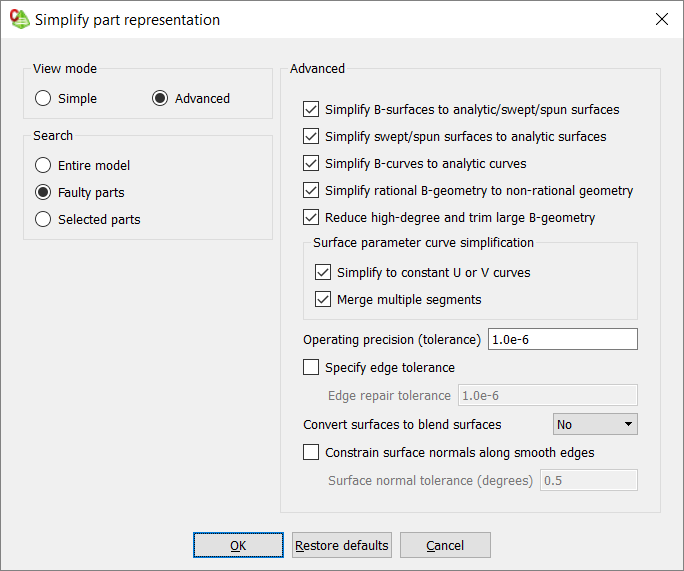Simplify Part Representation
The Simplify part representation tool simplifies a curve or a surface.
- simplification of rational and non-rational B-spline surfaces to analytic surfaces (plane, cylinder, sphere, cone, torus) where possible
- simplification of rational and non-rational B-spline curve to analytic curves (line, circle, ellipse)
- simplification of swept and spun surfaces to analytic surfaces (plane, cylinder, sphere, cone, torus) where possible
- simplification of surface parameter curves controlled by given options
On the Transform tab in the
Repair group, click the ![]() Simplify Part Representation icon.
Simplify Part Representation icon.

Advanced settings
- Simplify B-surfaces to analytic / swept / spun surfaces
- Any B-surfaces are simplified where possible to planes, cylinders, cones, spheres or tori where possible.
- Simplify swept / spun surfaces to analytic surfaces
- Any swept or spun surfaces are simplified to planes, cylinders, cones, spheres or tori.
- Simplify B-curves to analytic curves
- Any B-curves are simplified to lines, circles or ellipses.
- Simplify rational B-geometry to non-rational geometry
- Any rational B-surfaces are simplified to non-rational B-surfaces. Non-rational B-surfaces have fewer degrees of freedom than rational B-surfaces.
- Reduce high-degree and trim large B-geometry
- Any high-degree B-surfaces are trimmed or simplified to cubic B-surfaces.
- Simplify to constant U or V curves
- The tool will attempt to simplify SP-curves1 to be constant in one parameter (U or V).
- Merge multiple segments
- The tool will attempt to merge multiple curve segments into a single segment.
- Operating precision (tolerance)
- The tolerance for replacement geometry.
- Specify edge tolerance
- To be more consistent with the surfaces in the model, it may be the case that the distance changes in the surface geometry are more important than the exact locations of the edges. If this option is selected, a more lenient tolerance for edge geometry can be specified for Edge repair tolerance.
- Edge repair tolerance
- This is an optional tolerance to permit greater latitude in repairing edges.
- Convert surfaces to blend surfaces
- The surfaces are cleaned by attempting to simplify to blends.
- Constrain surface normals along smooth edges
- The tool will attempt to ensure that smooth edges will remain smooth2 since the maximum deviation between the normals for these faces will be equal to the surface normal tolerance.
- Surface normal tolerance (degrees)
- The angular tolerance for constraining surface normals in degrees.